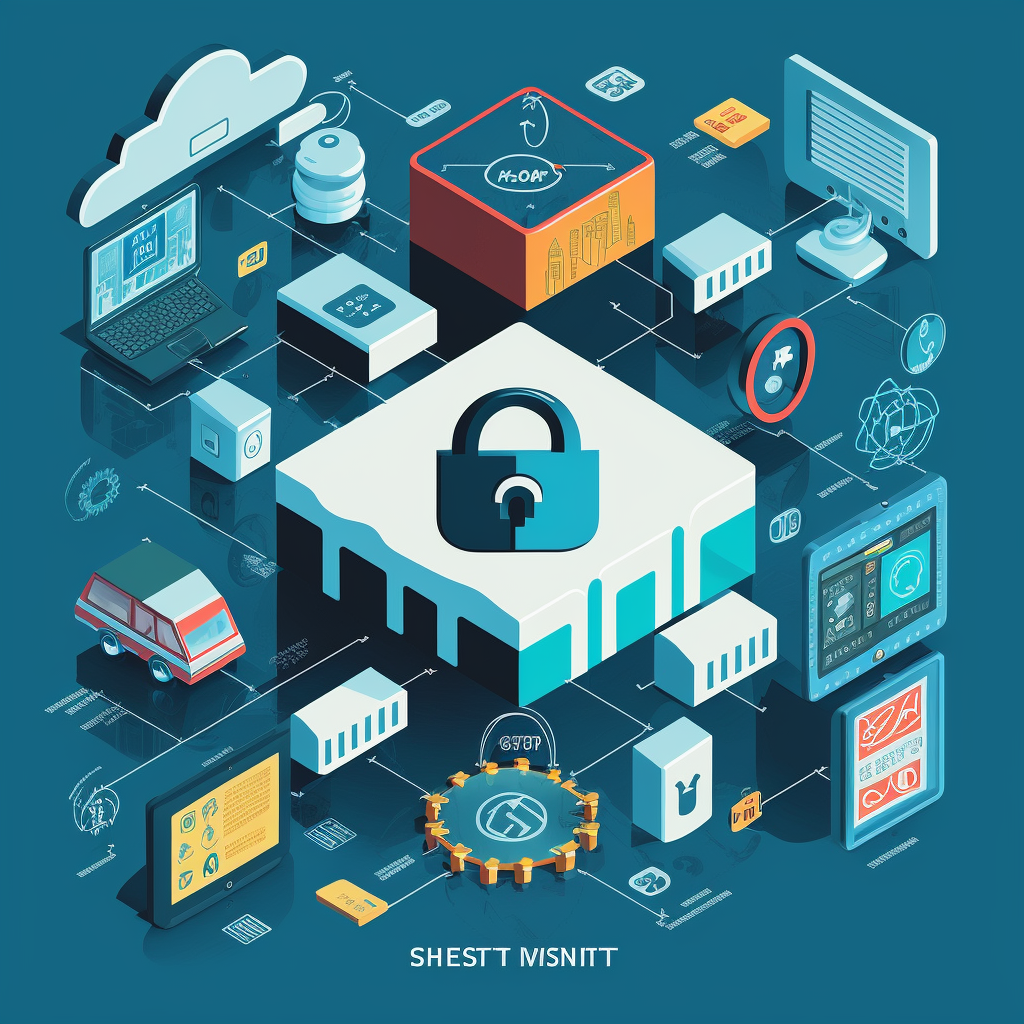A COMPREHENSIVE GUIDE TO INTERNET OF THINGS (IOT) SECURITY FOR SMALL AND MEDIUM-SIZED BUSINESSES (SMBS)

The Internet of Things (IoT) refers to the interconnected network of physical devices, vehicles, home appliances, and other items that are embedded with sensors, software, and network connectivity.
These devices collect and exchange data over the internet, enabling businesses to gather insights, optimize operations, and improve customer experiences.
IoT devices are becoming increasingly popular among small and medium-sized businesses (SMBs) due to their affordability, ease of use, and ability to improve business efficiency.
However, with the increasing prevalence of IoT devices in SMBs, there comes an increased risk of security breaches.
Hackers can exploit vulnerabilities in IoT devices to gain unauthorized access to sensitive business data, install malware, and even take control of entire systems.
This is why IoT security is critical for SMBs to safeguard their data and ensure business continuity.
This guide provides a comprehensive overview of IoT security for SMBs, including common security risks, best practices for securing IoT devices, compliance regulations, available IoT security tools and technologies, and employee training and education on IoT security.
By following the recommendations outlined in this guide, SMBs can significantly reduce the risk of IoT security breaches and protect their business from potential harm.
Common IoT Security Vulnerabilities
IoT devices are highly vulnerable to security breaches due to their widespread adoption, lack of standardization, and limited security features.
Common IoT security vulnerabilities that SMBs should be aware of include:
Weak authentication: Many IoT devices use default usernames and passwords that are easily guessable, making them susceptible to brute force attacks.
Inadequate encryption: IoT devices may not use encryption protocols to protect data, making it easier for hackers to intercept and steal sensitive information.
Lack of security updates: IoT devices may not receive regular security updates, leaving them vulnerable to new security threats.
Unsecured network communications: Many IoT devices communicate over unsecured networks, making them vulnerable to eavesdropping and man-in-the-middle attacks.
Physical tampering: IoT devices may be physically accessible, allowing attackers to physically tamper with them to gain unauthorized access.

Examples of IoT Security Breaches Affecting SMBs
IoT security breaches can have devastating consequences for small and medium-sized businesses (SMBs), including loss of customer trust, legal liabilities, and damage to the company’s reputation.
Here are some examples of IoT security breaches affecting SMBs:
Ransomware Attack: In 2020, a ransomware attack targeted a small UK-based firm that provides IoT services to a variety of industries. The hackers demanded a ransom in exchange for restoring access to the company’s systems, causing significant financial and reputational damage.
Medical Devices Hack: In 2017, a security researcher discovered a vulnerability in a medical device used by a US-based SMB that allowed hackers to access sensitive patient information. The breach caused significant damage to the company’s reputation and led to legal action.
Smart Locks Hack: In 2019, a security researcher demonstrated how smart locks used by SMBs can be easily hacked, allowing attackers to gain unauthorized access to offices and other secure locations. This breach highlighted the need for stronger security measures for IoT devices.
Industrial Control Systems Breach: In 2018, a small Canadian manufacturing company experienced a breach in their industrial control systems that led to significant production delays and lost revenue.
Internet-Connected Cameras Hack: In 2021, a hacker gained unauthorized access to internet-connected cameras used by a small US-based firm, allowing them to monitor the company’s activities and steal sensitive data.
The Impact of IoT Security Breaches on SMBs
IoT security breaches can have a significant impact on SMBs. The consequences of an IoT security breach can include loss of data, loss of revenue, legal liabilities, damage to reputation, and even business closure.
Moreover, SMBs may not have the resources to respond adequately to an IoT security breach, making them more vulnerable to the long-term impact of such attacks.
Given the potential risks and consequences of IoT security breaches, SMBs must take proactive measures to secure their IoT devices.
Best Practices for IoT Security in SMBs
To mitigate the risk of IoT security breaches, SMBs should implement the following best practices:
1. Conducting a Risk Assessment of IoT Devices
SMBs should start by conducting a thorough risk assessment of their IoT devices. This will help them identify potential security risks and vulnerabilities, prioritize security needs, and develop an effective security strategy.
2. Implementing Strong Passwords and Authentication Methods
To prevent unauthorized access to IoT devices, SMBs should implement strong passwords and authentication methods. Passwords should be complex and unique, and authentication should be multifactor, such as using biometric data or a security token.
3. Regularly Updating Software and Firmware
SMBs should ensure that their IoT devices receive regular security updates and patches. This includes updating software and firmware to fix known vulnerabilities and prevent new security threats from emerging.
4. Segmenting IoT Devices on Separate Networks
To prevent attackers from gaining unauthorized access to other devices on the network, SMBs should segment IoT devices on separate networks. This will limit the impact of a security breach and prevent lateral movement of attackers.
5. Limiting Access to IoT Devices
SMBs should limit access to IoT devices to only authorized personnel. This includes implementing access controls and policies that restrict access based on the user’s role and level of authorization.
6. Monitoring IoT Devices for Suspicious Activity
SMBs should monitor their IoT devices for suspicious activity and potential security breaches. This includes implementing real-time monitoring and alert systems that detect anomalies and suspicious behavior.
7. Creating an Incident Response Plan for IoT Security Breaches
SMBs should have an incident response plan in place in case of an IoT security breach. This plan should include steps to contain the breach, assess the damage, and recover from the attack.
By implementing these best practices, SMBs can significantly reduce the risk of IoT security breaches and protect their business from potential harm. It is essential to prioritize IoT security and allocate the necessary resources to ensure that IoT devices are secure and protected.

IoT Security Compliance and Regulations for SMBs
1. Overview of Relevant Regulations
SMBs must comply with various regulations and standards related to IoT security to protect customer data and avoid legal liabilities. Examples of relevant regulations include:
General Data Protection Regulation (GDPR): The GDPR applies to all companies processing personal data of EU residents and requires them to implement adequate security measures to protect this data.
Health Insurance Portability and Accountability Act (HIPAA): HIPAA regulates the collection, storage, and sharing of personal health information and requires healthcare organizations to implement specific security measures.
Cybersecurity Information Sharing Act (CISA): The CISA encourages information sharing on cybersecurity threats and vulnerabilities between the government and the private sector.
2. The Impact of Non-Compliance on SMBs
Non-compliance with IoT security regulations can have severe consequences for SMBs. Companies may face legal action, fines, loss of reputation, and loss of customers due to breach notification requirements.
3. Steps SMBs Can Take to Comply with IoT Security Regulations
To comply with IoT security regulations, SMBs can take the following steps:
Identify the relevant regulations that apply to their business and assess the impact of non-compliance.
Implement security controls and best practices that comply with the regulations, such as encryption, access controls, and data protection policies.
Regularly assess the effectiveness of their security controls and update them as necessary to meet changing regulations and security threats.
Educate employees on IoT security regulations and best practices to ensure that they understand their role in compliance.
Partner with an experienced IoT security provider who understands the regulations and can help SMBs meet their compliance requirements.
By taking these steps, SMBs can ensure that they comply with IoT security regulations and protect their business from potential harm. It is crucial to prioritize compliance and allocate the necessary resources to ensure that IoT devices are secure and protected in accordance with the relevant regulations.
IoT Security Tools and Technologies for SMBs
1. Overview of Available IoT Security Tools and Technologies
There are various IoT security tools and technologies available for SMBs to protect their IoT devices from security threats. Some of the most popular IoT security tools and technologies include:
Firewalls: Firewalls can be used to filter traffic and protect IoT devices from unauthorized access.
Intrusion Detection and Prevention Systems (IDPS): IDPS can be used to detect and prevent potential security breaches in real-time.
Data Encryption: Data encryption can be used to protect sensitive data that is stored or transmitted over IoT devices.
Authentication and Authorization: Authentication and authorization tools can be used to ensure that only authorized users have access to IoT devices.
Endpoint Protection: Endpoint protection tools can be used to protect IoT devices from malware and other cyber threats.
2. How to Choose the Right IoT Security Solutions for Your SMB
When choosing IoT security solutions for their business, SMBs should consider the following factors:
Security Needs: SMBs should evaluate their IoT security needs and identify the types of security threats they are most vulnerable to.
Ease of Use: SMBs should choose IoT security solutions that are easy to use and manage, as they may not have dedicated IT staff to manage security.
Scalability: SMBs should choose IoT security solutions that can scale as their business grows and as their security needs evolve.
Compatibility: SMBs should choose IoT security solutions that are compatible with their existing infrastructure and IoT devices.
Support: SMBs should choose IoT security solutions that come with reliable support and maintenance services.
3. Cost Considerations for IoT Security Tools and Technologies
The cost of IoT security tools and technologies can vary widely depending on the type of solution and the vendor. SMBs should consider the following cost factors when choosing IoT security solutions:
Upfront Costs: SMBs should consider the initial investment required to purchase and install IoT security solutions.
Ongoing Costs: SMBs should consider the ongoing costs associated with maintaining and managing IoT security solutions, including licensing fees, subscription fees, and support costs.
Return on Investment: SMBs should consider the potential return on investment (ROI) of IoT security solutions in terms of improved security, reduced risk, and increased business efficiency.
By carefully considering their security needs, ease of use, scalability, compatibility, support, and cost factors, SMBs can choose the right IoT security solutions to protect their business from potential harm.
It is essential to prioritize IoT security and allocate the necessary resources to ensure that IoT devices are secure and protected using the most effective and affordable solutions available.

IoT Security Training and Education for SMBs
1. The Importance of Educating Employees on IoT Security Best Practices
Employee awareness and training on IoT security best practices are crucial to prevent security breaches caused by human error.
Employees should be educated on the importance of IoT security, potential security threats, and how to detect and prevent security breaches.
Educating employees on IoT security best practices can also improve overall security awareness and culture in the organization.
2. How to Train Employees on IoT Security
When training employees on IoT security, SMBs should consider the following best practices:
Develop a training program that covers IoT security policies, procedures, and best practices.
Tailor training to specific job roles and responsibilities.
Use real-world examples to demonstrate the impact of IoT security breaches.
Provide hands-on training and simulations to help employees understand how to identify and respond to security threats.
Provide ongoing support and resources to reinforce training and answer employee questions.
3. Ongoing Education and Awareness Initiatives for IoT Security
IoT security threats and best practices are constantly evolving, making ongoing education and awareness initiatives essential. SMBs should consider the following ongoing education and awareness initiatives for IoT security:
Regularly communicate IoT security updates and best practices to employees.
Provide regular cybersecurity awareness training for all employees.
Establish an IoT security incident reporting and response process.
Conduct regular security audits and assessments to identify potential vulnerabilities.
Develop an ongoing IoT security education and awareness plan to ensure that employees are kept up-to-date on the latest security threats and best practices.
By prioritizing employee training and education on IoT security best practices, SMBs can significantly reduce the risk of security breaches caused by human error.
It is essential to establish a culture of security awareness and ongoing education to ensure that employees are equipped to identify and respond to security threats effectively.
Conclusion – Internet of Things (IoT) Security
IoT devices are becoming increasingly prevalent in SMBs due to their affordability, ease of use, and ability to improve business efficiency.
However, with the increasing prevalence of IoT devices in SMBs, there comes an increased risk of security breaches. Hackers can exploit vulnerabilities in IoT devices to gain unauthorized access to sensitive business data, install malware, and even take control of entire systems.
This is why IoT security is critical for SMBs to safeguard their data and ensure business continuity.
In this guide, we have provided a comprehensive overview of IoT security for SMBs.
Securing IoT devices in SMBs requires a proactive and comprehensive approach that considers the unique security risks and compliance requirements of each business.
SMBs should prioritize IoT security and allocate the necessary resources to ensure that IoT devices are secure and protected using the most effective and affordable solutions available.
This includes implementing best practices for IoT security, staying up-to-date with the latest security threats and vulnerabilities, and investing in IoT security tools and technologies to protect against attacks.
Additionally, SMBs should prioritize employee training and education on IoT security best practices to prevent security breaches caused by human error.
By following these guidelines, SMBs can ensure that their IoT devices are secure and protected, allowing them to focus on running their business without worrying about potential security threats.
Secure your business from potential cyber threats with Cyb-Uranus, the trusted Cyber Security consulting firm for SMBs. Our team of experts can help you develop a comprehensive and tailored Cyber Security program to protect your business data and ensure compliance with regulations. Contact us today to safeguard your business from cyber attacks and gain peace of mind.”
References
https://www.iotsecurityfoundation.org/

